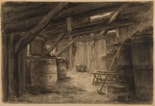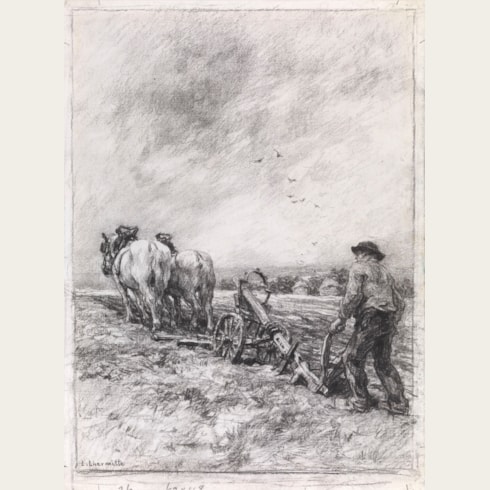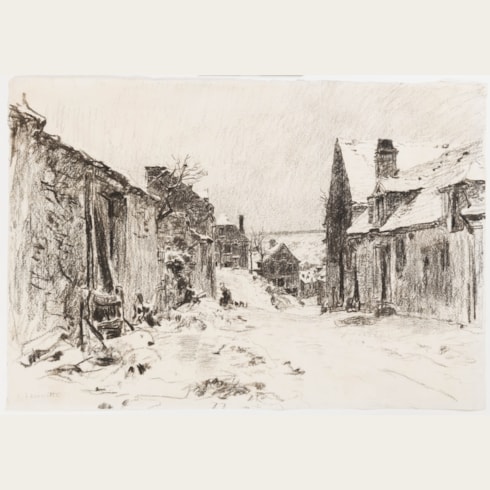Léon Augustin LHERMITTE
(Mont-Saint-Père 1844 - Paris 1925)
The Interior of a Barn
Charcoal.
Signed L. Lhermitte at the lower left.
307 x 451 mm. (12 1/8 x 17 3/4 in.) [sheet]
Signed L. Lhermitte at the lower left.
307 x 451 mm. (12 1/8 x 17 3/4 in.) [sheet]
The Lhermitte scholar Monique Le Pelley Fonteny has written of the artist that, ‘In his drawings he achieved a masterful subtlety between light and shadow, white and black, about which Théodore de Banville once remarked: “In his hands charcoal and black chalk are like magical tools.”’ The artist's charcoal drawings, or fusains, were avidly collected in France, England and America.
Lhermitte produced finished charcoal drawings of peasant interiors throughout his career, and the present sheet can de compared with a number of drawings of this type, such as a Sheep Barn in the Philadelphia Museum of Art and an unsigned drawing of The Interior of a Forge in the Musée Jean de La Fontaine in Château-Thierry. Also comparable is a drawing of the courtyard of a farm, in the Fondation Custodia in Paris.
Lhermitte produced finished charcoal drawings of peasant interiors throughout his career, and the present sheet can de compared with a number of drawings of this type, such as a Sheep Barn in the Philadelphia Museum of Art and an unsigned drawing of The Interior of a Forge in the Musée Jean de La Fontaine in Château-Thierry. Also comparable is a drawing of the courtyard of a farm, in the Fondation Custodia in Paris.
Léon Augustin Lhermitte studied at the École Imperiale du Dessin, and exhibited for the first time at the Salon of 1864. In 1868 he visited London, and in 1874 won a third-class medal at the Salon for his painting The Harvest. It was also in 1874 that Lhermitte spent several months working in Brittany. He was to return frequently over the next five years, during which time he showed Breton subjects at the Salon. In 1882 he achieved a considerable measure of success with the exhibition of his painting The Paying of the Harvesters, which was purchased by the State on the opening day of the Salon. From this point onwards he began to concentrate on depictions of rural and peasant life, centred on his native town of Mont-Saint-Père, on the banks of the Marne river in Picardy. In 1887 Lhermitte signed a contract with the gallery Boussod, Valadon & Cie. which gave them the exclusive rights to his paintings and pastels, though not his drawings. He enjoyed considerable commercial and critical success throughout his long career, and his paintings and drawings of daily life in the countryside were especially popular with British and American collectors. As one scholar has noted, ‘To Lhermitte, rustic activity embodied dignity, for he believed workers in the fields seldom complained about their lot in society...Lhermitte fabricated a serene and peaceful image of rustic life that competently conveyed an idyllic vision to his highly receptive audience.’ In 1890 he began exhibiting annually at the newly-established Société Nationale des Beaux-Arts, where he was given the honour of a retrospective exhibition in 1924, the year before his death. Lhermitte left a thorough record of his output – of paintings, watercolours, drawings and pastels - in notebooks that he kept between 1863 and 1897.
As a draughtsman, Lhermitte produced mainly pastels and charcoal drawings, for which he was very highly regarded. The former were much sought-after, and were exhibited yearly at the Société des Pastellistes and sold through his dealers Boussod & Valadon. His charcoal drawings were also exhibited widely as independent works, in both France and London, and were much praised by critics. As one anonymous writer noted in a review of the third Black and White Exhibition at the Dudley Gallery in London in 1875, when nine charcoal drawings by Lhermitte were exhibited: ‘we should be disposed to put Léon Lhermitte at the head of all those who exhibit here for the most potent secrets of strength and command of effect in black and white...to such qualities in his black and white, as delicacy of draughtsmanship, exquisiteness and sweetness of effect, and refinement of expression, Lhermitte’s work makes no pretension. It assails the imagination by a rude, massive, and primitive strength akin to that which impresses us in the monuments and buildings, the life and faith, of that Brittany from which he derives most of his subjects, and in which his genius seems most at home. How eminently favourable this stern simplicity is to effect, in such materials as chalk and charcoal...It is impossible to forget Lhermitte’s work. He is at once the Millet and Jules Breton of Black and White.'
The Lhermitte scholar Monique Le Pelley Fonteny has written of the artist that, ‘In his drawings he achieved a masterful subtlety between light and shadow , white and black, about which Théodore de Banville once remarked: “In his hands charcoal and black chalk are like magical tools.”’ Lhermitte’s charcoal drawings, or fusains, were avidly collected in France, England and America, and were also much admired by other artists, notably Vincent Van Gogh, who noted of Lhermitte in a letter to his brother Theo, written in September 1885, ‘He’s a master of the figure. He’s able to do what he likes with it - conceiving the whole neither from the colour nor from the local tone, but rather proceeding from the light - as Rembrandt did - there’s something astonishingly masterly in everything he does - in modelling, above all things, he utterly satisfies the demands of honesty...When I think about Millet or about Lhermitte – then - I find modern art as great – as Michelangelo and Rembrandt - the old infinite, the new infinite too - the old genius, the new genius.’






